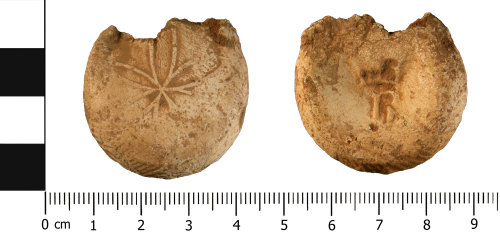
Rights Holder: Birmingham Museums Trust
CC License: ![]()
Image use policy
Our images can be used under a CC BY attribution licence (unless stated otherwise).
AMPULLA
Unique ID: WMID-EF658A
Object type certainty: Certain
Workflow
status: Awaiting validation ![]()
An incomplete lead or lead alloy pilgrims ampulla dating from the medieval period; circa late 13th - late 15th century (AD 1250-1500).
The fragment consists of the main rounded body of the ampulla. The neck of the ampulla is missing. On one face the object has been decorated with a floral cast motif consisting of radiating petals formed from ribs in light relief. At the lower outer edge of the rounded body is a zig zag patttern formed from a series of diagonal ribs located close to one another. this can be seen on both faces. In the centre of the opposing face is a stamped capital letter 'R' with crown above. As seen on other examples recorded on the PAS database such as (LIN-5B2AD1) discovered in Lincolnshire and (NMS-A7S3) discovered in Suffolk; the letter "R" is suggested as possible representing Richelde, the founder of the Holy House at Walsingham. The ampulla has a cream coloured abraded patina across all surfaces.
Spencer (1990) suggests that ampullae were used to contain holy water, as a souvenir of a pilgrimage and date to the 13th to 15th centuries. It has been suggested that many of these are found unconnected with religious sites (specifically in East Anglia) and it is thought that they could have been used and discarded in a religious ceremony to bless the fields. The scallop design was the emblem of St. James the Greater from the 12th century, but became the generic symbol of pilgrimage itself, therefore representing all pilgrim saints and for all pilgrims (Spencer, 1990, 41). Ampullae are often found in rural areas which may reflect the folk practice such as burying the ampulla in fields to protect crops and livestock from illness (Spencer, 1990, 205). Similar examples can also be found illustrated in Spencer (1990: p.59-62) No's 127-146.
The fragment measures, 32.12 mm in Length, 32.44 mm in width, 9.3 mm in thickness and weighs 26.5 grams
Spencer, B. (1990) Pilgrim Souvenirs & Secular Badges.Salisbury Museum Medieval Catalogue Part 2. Salisbury, Salisbury & South Wiltshire Museum.
Inscription:
'R'
Subsequent actions
Subsequent action after recording: Returned to finder
Chronology
Broad period: MEDIEVAL
Period from: MEDIEVAL
Period to: MEDIEVAL
Date from: Circa AD 1250
Date to: Circa AD 1500
Dimensions and weight
Quantity: 1
Length: 32.12 mm
Width: 32.44 mm
Thickness: 9.3 mm
Weight: 26.5 g
Personal details
This information is restricted for your access level.
Materials and construction
Primary material: Lead Alloy
Manufacture method: Cast
Completeness: Fragment
Spatial metadata
Region: West Midlands (European Region)County or Unitary authority: Shropshire (Unitary Authority)
District: Shropshire (Unitary Authority)
Parish or ward: Rudge (Civil Parish)
Spatial coordinates
4 Figure: SO8197
Four figure Latitude: 52.57048721
Four figure longitude: -2.28176574
1:25K map: SO8197
1:10K map: SO89NW
Grid reference source: Centred on village (which isn't a parish)
Unmasked grid reference accurate to a 10 metre square.
References cited
No references cited so far.
Similar objects

Find number: WMID-D840F7
Object type: AMPULLA
Broadperiod: MEDIEVAL
An incomplete lead or lead alloy pilgrims ampulla dating to the Medieval period, circa late 13th - late 15th century (AD 1250-1500).
The…
Workflow: Awaiting validation![]()

Find number: WMID-89D33F
Object type: AMPULLA
Broadperiod: MEDIEVAL
A fragment of a lead alloy pilgrims ampulla dating from the Medieval period; circa late 13th - late 15th century (AD 1250-1500).
Approxi…
Workflow: Awaiting validation![]()

Find number: WMID-427596
Object type: AMPULLA
Broadperiod: MEDIEVAL
A fragment of a lead alloy pilgrims ampulla dating from the Medieval period; circa late 13th - late 15th century (AD 1250-1500).
Over 50% of …
Workflow: Awaiting validation![]()


